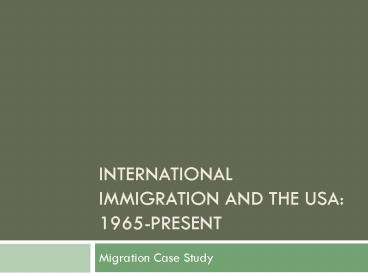International Immigration and the USA: 1965-present - PowerPoint PPT Presentation
1 / 40
Title:
International Immigration and the USA: 1965-present
Description:
INTERNATIONAL IMMIGRATION AND THE USA: 1965-PRESENT Migration Case Study Geographic Propinquity (ie, proximity), gateway centers , and Chain Migration Patterns ... – PowerPoint PPT presentation
Number of Views:39
Avg rating:3.0/5.0
Title: International Immigration and the USA: 1965-present
1
International Immigration and the USA
1965-present
- Migration Case Study
2
America and the New Immigrants 1965 the
present
- 1990 foreign-born population is 8 (20 million)
- 2000 foreign-born population is 11 (28 million)
- 2008 foreign-born population is 12 (33 million)
- What about 2010? Role of current economic
recession (2008-present)?
3
(No Transcript)
4
(No Transcript)
5
(No Transcript)
6
(No Transcript)
7
(No Transcript)
8
(No Transcript)
9
(No Transcript)
10
(No Transcript)
11
(No Transcript)
12
Melting Pot Metros metropolitan areas with NO
racial/ethnic majority
- Miami-Fort Lauderdale 5.5 million
- Hispanics 40.3
- Whites 36.3
- African-American 20.6
- Asians 2.2
13
- Los Angeles 16 million
- Hispanics 40.7
- Whites 39.0
- Asians 11.5
- African-American 7.8
14
Close to melting pot metro status
- San Francisco-Oakland-San Jose 7.7 million
- Whites 50.6
- Asians 20.5
- Hispanics 19.7
- African-American 7.8
15
- Chicago-Gary-Kenosha 9 million
- Whites 59.4
- African-American 18.8
- Hispanics 16.4
- Asians 4.7
16
Diversity of the New Immigrants
- Diversity of origins (100s countries vs. 10s)
every continent is well represented - Ethnicity
- Language
- Religion
- Largest share Mexico (29.5 of total)
- Diversity of education and skills
- 33 are professional (H1B Visas)
- Labor Migrants (58)
- Entrepreneurial Immigrants (5)
- Political Refugees and Asylees (9)
17
(No Transcript)
18
(No Transcript)
19
(No Transcript)
20
(No Transcript)
21
Other Key Differences with the past
- Internal Geography
- Very Metropolitan (urban)
- 95 metropolitan
- 5 rural/small town
- Highly concentrated pattern (71 in just 5
states) - California
- New York
- Texas
- New Jersey
- Illinois
22
(No Transcript)
23
The end.off to Chapter 5 (language)
24
What Explains this resurgence in immigration?
- The Conventional Wisdom (mostly wrong)
- Overpopulation
- Poverty
- Economic Stagnation
- Rather, well use the concept of Relative
deprivation - The Mechanic in Mexico
- The medical researcher in India
- IN THE CONTEXT of intensifying GLOBALIZATION
25
A complex array of factors explain the New
Immigration
- 1. Legal Framework changes
- 2. Globalization
- a. US as a global culture
- b. Internationalization of Production
- c. New Labor Demand in the US
- G(entrification)
- H(igh tech)
- I(nformalization of manufacturing)
- 3. Specific Actors
- Universities
- The Military
26
Changes in the legal framework
- 1965 Immigration Act
- Reverses the 1924 restrictions
- Removes quotas that favor Europe, and Europeans
- Family reunification
- Political Asylum considerations
- HB1 Visas
27
Globalization
- US as a global culture
28
- Internationalization of Production
29
New Labor Demand in the US
- 1 Gentrification (when neighborhoods transition
from working-class to professional class
30
New Labor Demand in US
- 2 High-Tech
- HB1 Visa increase in tandem with high-tech boom
of the 1990s - Decrease after high-tech bust
31
New Labor Demand in US
- 3 Informalization of Manufacturing
- Industrial sweatshops
- De-unionization
- Food processing/packaging has increased in
relative importance.
32
Other Contributing Factors
- 1 Universities
- American universities collectively are the
largest grouping of post-secondary institutions
in the world - Much of cutting-edge research occurs in the US
(although decreasing a share) - 2 The role of the military
- Bases and operations
- Past examples Korea, Vietnam, Dominican
Republic, Philippines - Current examples Afghanistan, Iraq
33
(No Transcript)
34
Geographic Propinquity (ie, proximity), gateway
centers, and Chain Migration Patterns (1965
present)
- Regional Variance
- San Francisco Mexico, Philippines
- Los Angeles Mexico, El Salvador
- Houston Mexico, El Salvador
- Chicago Mexico, Poland
- New York Dominican Republic, Jamaica
- Washington El Salvador, Korea
- Miami Cuba, Columbia
35
New Immigrant Typology (types)
- 1. Labor Migrants (58)
- 2. Professional Immigrants (33)
- 3. Entrepreneurial Immigrants (5)
- 4. Political Refugees and Asylees (9)
36
Median Household Income by Immigrant National
Group (1989)
- Above national average (32,000)
- Indians 48,320
- Iranians 35,836
- Greeks 33,500
- Around national average
- Irish 31,562
- Chinese 30,597
- Jamaicans 30,590
- Poles 29,964
- Below national average
- Mexicans 21,926
- Cambodians 19,671
- Ex USSR 19,125
37
Labor Migrants
- Where from?
- Mexico
- Central America
- Eastern Europe
- Who?
- The most ambitious of the working class, not the
poorest of the poor, relative depravation - Why?
- Wage differentials
- Contract labor
- Marriage, family reunification
- Who supports and who doesnt?
- Dependent businesses support
- Unions sometimes do not
- Environmentalists sometimes do not
38
Professional Immigrants
- Where from?
- China/Taiwan
- India
- Western Europe
- Why?
- Relative depravation, reach the upper tiers of
their chosen career paths - Role of technology in allowing for dual
citizenship, and trans-national identity. - Who?
- Technical elite, educated elite (HBI Visas)
- Who supports, who doesnt?
- Businesses generally support
- Environmentalists sometimes do not
- Property owners in fast-growing, high-tech areas
39
Entrepreneurial Immigrants
- Where from?
- Korea
- India
- China
40
Political Asylees
- Where from?
- Countries effected by US military campaigns
- Those from communist countries
- Those from countries considered by the US
government to have dictatorial government - Key distinction here is that is the decisions
made by GOVERNMENT that matter - Why?
- Human rights policy, geo-political strategy
- Who?
- Often displaced peasants, and middle-class
business owners






























